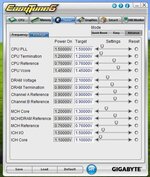@wurli1
Komplettes Template vom Bios posten.
Moin,
würde ich ja gerne machen, aber wie? Macht ihr das mit einem Programm oder wurden die Einstellungen (BIOS) abgeschrieben?

EDIT:
Hab´s von oben mal kopiert und abgepasst:
MB Intelligent Tweaker(M.I.T.)
Robust Graphics Booster ...............: Auto
CPU Clock Ratio .......................: 8x
Fine CPU Clock Ratio...................:.+0.00
CPU Frequency .........................: 4000Mhz
Clock Chip Control
Standard Clock Control
CPU Host Clock Control..................: [Enabled]
CPU Host Frequency (Mhz) ............: 500MHz
PCI Express Frequency (Mhz) .........: 101Mhz
C.I.A. 2.......................................: Disabled
Advanced Clock Control [Press Enter]
CPU Clock Drive.......................: 800mv
PCI Express Clock Drive...............: 900mv
CPU Clock Skew (ps)...................: 0ps
MCH Clock Skew (ps)...................: 0ps
DRAM Performance Control
Performance Enhance....................: [Standard]
Extreme Memory Profile (X.M.P.)........: Auto
(G)MCH Frequency Latch.................: 333
System Memory Multiplier ..............: 2.00B
Memory Frequency (Mhz) ................: 1000Mhz
DRAM Timing Selectable ................: manual
Standard Timing Control
CAS Latency Time..............................: 5
tRCD .........................................: 5
tRP'..........................................: 5
tRAS..........................................: 15
Advanced Timing Control [Press Enter]
tRRD...................................: Auto
tWTR...................................: Auto
tWR....................................: Auto
tRFC...................................: Auto
tRTP...................................: Auto
Command Rate (CMD) ....................: Auto
Channel A
Channel A Timings Settings [Press Enter]
Static tRead Value.....................: 10
tRD Phase0 Adjustmen...................: Auto
tRD Phase1 Adjustment..................: Auto
tRD Phase2 Adjustment .................: Auto
tRD Phase3 Adjustment..................: Auto
Trd2rd(Different Rank).................: Auto
Twr2wr(Different Rank).................: Auto
Twr2rd(Different Rank).................: Auto
Trd2wr(Same/Diff Rank).................: Auto
Dimm1 Clock Skew Control...............: Auto
Dimm2 Clock Skew Control...............: Auto
DDR Write Training......................: Auto
Channel A Driving Settings [Press Enter]
Driving Strength Profile.................: Auto
Data Driving Pull-Up Level.............: Auto
Cmd Driving Pull-Up Level..............: Auto
Ctrl Driving Pull-Up Level.............: Auto
Clk Driving Pull-Up Level..............: Auto
Data Driving Pull-Down Level..........: Auto
Cmd Driving Pull-Down Level...........: Auto
Ctrl Driving Pull-Down Level..........: Auto
Clk Driving Pull-Down Level...........: Auto
Channel B
Channel B Timings Settings [Press Enter]
Static tRead Value......................: 10
tRD Phase0 Adjustmen....................: Auto
tRD Phase1 Adjustment...................: Auto
tRD Phase2 Adjustment ..................: Auto
tRD Phase3 Adjustment..................: Auto
Trd2rd(Different Rank).................: Auto
Twr2wr(Different Rank).................: Auto
Trd2rd(Different Rank).................: Auto
Trd2wr(Same/Diff Rank).................: Auto
Dimm1 Clock Skew Control...............: Auto
Dimm2 Clock Skew Control...............: Auto
DDR Write Training....................: Auto
Channel B Driving Settings [Press Enter]
Driving Strength Profile................: Auto
Data Driving Pull-Up Level..............: Auto
Cmd Driving Pull-Up Level...............: Auto
Ctrl Driving Pull-Up Level..............: Auto
Clk Driving Pull-Up Level...............: Auto
Data Driving Pull-Down Level...........: Auto
Cmd Driving Pull-Down Level............: Auto
Ctrl Driving Pull-Down Level...........: Auto
Clk Driving Pull-Down Level.............: Auto
{U]Motherboard Voltage Control{/U]
Loadline Calibration.………...........: enabled
CPU Vcore….……….....................: 1,45V
CPU Termination…..... 1.200V*......: Normal
CPU PLL…………………....1.500V*..........: Normal
CPU Referen.…………....0.76V*.........: Normal
MCH/ICH
MCH termination...1.100V...........: 1,3V
MCH Reference….…….0.760V...........: Normal
MCH/DRAM Ref.…......0.900V.........: Normal
ICH I/O……………….....1.50V............: Normal
ICH Core…………...……1.100V............: Normal
DRAM
DRAM Voltage ……....1.800V.............: 2,10V
DRAM Termination .…0.900V.............: Normal
Channel A Reference 0.900V............: Normal
Channel B Reference 0.900V............: Normal
Das Board von JZ und mit ´nem Quad 500*8*2.00B pretested (MCH 1,3V).






 . Bei dir war es eben die Vcore =).
. Bei dir war es eben die Vcore =).




 ICH BRAUCH ES
ICH BRAUCH ES 




